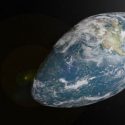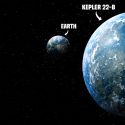Ah, the planet Earth, our beautiful home. We’d like to believe it will be around forever, but what if it isn’t? Aliens, comets, weapons of mass destruction, black holes, even the Sun could destroy the Earth.
What’s it going to be? How will it affect you, or your descendents? And would we be able to stop it?
In July of 2019, we had a narrow miss with asteroid 2019 OK. It’s impact would have been similar to a nuclear bomb.
And the scariest thing? Scientists didn’t see it coming until it was too late.
NASA would need a whole year’s notice to stop a doomsday collision. How would they do that? They’d launch an object into space to collide with the asteroid, destroying it before it got close to Earth.
Barring any more immediate dangers, will the Earth still die? What will it look like in the near future and the distant future? What could we do to save the Earth?
Earth wasn’t always the diverse paradise we know it as. In fact, about 4 billion years ago, it looked more like something from a sci-fi movie.
Supervolcanoes, meteors, and a toxic atmosphere made our planet inhospitable. So how did it become today’s Earth?
It went through many geological, atmospheric and evolutionary steps. In fact, homo sapiens only came into the story about 200,000 years ago.
Human life evolved during a time when the climate was mild and stable, enabling a vast diversity of life – something we take for granted. Today, we are already beginning to see the effects of rapid changes to our climate and the destruction it causes.
What will the future look like if we continue down this path? How will it affect your children?
The next hundred years will see temperatures rise 6° C (3° F). That may not seem like a lot, but it is enough to create droughts, extreme wildfires, stronger hurricanes, and food shortages.
Two hundred years into the future, the world’s population will reach 9 billion. Hopefully, we spend all that time between now and then creating new technology to offset the environmental destruction and keep up with the demand for food.
In 300 years, humanity will be considered a Type 1 civilization on the Kardashev scale, which means we use all the available resources on our planet. If only we could get to Type II and use the power of the Sun, or even Type III, which uses galactic power.
These are all things that could affect your direct descendants. But let’s jump even further into the future, when humans may or may not even be around.
In 100,000 years from now, the biggest star in the Milky Way, Canis Majoris, will explode. The supernova will be visible from Earth in pure daylight.
As this is going on, 20 supervolcanoes will spew out 417 cubic kilometers of magma in all directions. At this point, Earth will be starting to resemble the planet we saw 4 billion years ago.
In 600 million years, the Sun will begin to burn up the Earth, as the Sun gets hotter from its shrinking core. The only life left on Earth 800 million years into the future will, once again, be single-celled organisms.
And 2.8 billion years into the future, the Earth’s temperature will be a scorching 150°C (302° F). There will be no life left on Earth.
Can we stop this slow demise into a piece of lifeless rock? Probably not.
In fact, our current actions might even be speeding up the process. Instead, we could work towards prolonging this calm period in Earth’s history, by protecting its life-sustaining ecosystems and using renewable resources.
The end of the Earth has captured many people’s imaginations. There are even doomsday groups with specific theories on how the end will come.
Some people believe that aliens will show up and wipe us out, maybe because of our rich natural resources, or maybe they just won’t like us. Other people believe that we will be sucked into a planet-destroying black hole caused by the Large Hadron Collider.
Oh, and don’t forget deathly gamma-ray bursts, which can produce as much energy in one millisecond as the Sun does in its entire lifetime. What about us? Can we destroy the Earth with weapons of mass destruction?
Luckily, no. We might be able to wipe humanity out, but to physically destroy the Earth is not possible.
The most powerful explosive device detonated – so far- is the Soviet-built Tsar Bomba, also called Big Ivan. The 50 megaton hydrogen bomb detonated in 1961 in the Arctic, was over 3,000 times more powerful than the bomb that destroyed Hiroshima.
We’d need one quadrillion Tsar Bombas to obliterate the Earth. In the long term, the Earth will eventually die.
But hopefully we can fend of any immediate disasters, and use that time to figure out a way to continue our existance through technological and biological advances. How would the human race react to the news that the Earth, like any living organism, is on its way toward the great beyond? Would it divide or unify us?
Even though the Earth will die – whether that’s sooner or later – we can make it a better place while we’re here. For now, this is all we’ve got. So let’s take better care of the environment, maybe stay away from weapons of mass destruction, we don’t want to risk a World War III…
Subscribe to What-If on YouTube or follow the show on Facebook Watch.
Sources
- “A ‘city-killer’ asteroid got scarily close to Earth, and astronomers didn’t know about it till it was just days away”. Aylin Woodward, 2020. Business Insider. Accessed February 17 2020.
- “The sun will destroy Earth a lot sooner than you might think”. Ali Sundermier, 2018. The Independent. Accessed February 17 2020.
- “Dino-Killing Asteroid Hit Just the Right Spot to Trigger Extinction“. 2017. nationalgeographic.com. Accessed February 17 2020.
- “Last days of Earth: timeline to the end of everything”. 2020. New Scientist. Accessed February 17 2020.
- “How life evolved: 10 steps to the first cells”. Lane, Michael. 2020. New Scientist. Accessed February 17 2020.
- “Captured: the moment photosynthesis changed the world”. Barras, Colin. 2012. New Scientist. Accessed February 17 2020.
- “Microbes found at bottom of ocean are our long-lost relatives”. Sarchet, Penny. 2020. New Scientist. Accessed February 17 2020.
- “Comb jellies possibly first lineage to branch off evolutionary tree”. Adam Jones, 2017. phys.org. Accessed February 17 2020.



























